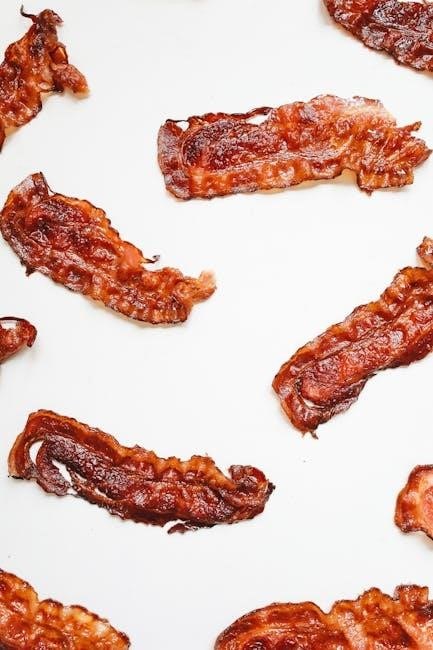What are Whitening Strips?
Whitening strips are thin‚ flexible pieces of plastic coated with a gel containing a whitening agent․ These strips are designed to be applied to the teeth‚ delivering the whitening agent to the enamel and helping to remove stains and discoloration for a brighter smile․

How Whitening Strips Work
The effectiveness of whitening strips lies in the bleaching agents present in the gel coating․ These agents‚ typically hydrogen peroxide or carbamide peroxide‚ penetrate the enamel layer of the teeth․ This process breaks down stain molecules that cause discoloration from factors like coffee‚ smoking‚ or aging․ When the whitening agent comes into contact with these stain molecules‚ a chemical reaction occurs‚ lightening the overall appearance of the teeth․ The strips ensure consistent contact between the gel and the tooth surface‚ maximizing the whitening effect during the application period․ This convenient method gradually lifts stains‚ resulting in a noticeably brighter smile with regular use‚ following the product instructions․

Ingredients in Whitening Strips
The primary active ingredients in whitening strips are typically hydrogen peroxide or carbamide peroxide․ These compounds act as bleaching agents‚ breaking down stain molecules on the teeth․ Other common ingredients include glycerin‚ which helps maintain moisture and consistency‚ and water‚ serving as a solvent․ Some strips contain flavoring agents to improve taste and reduce the chemical aftertaste․ Thickeners like carbomer may be added to enhance the gel’s viscosity‚ ensuring it adheres properly to the teeth․ Additionally‚ ingredients like sodium hydroxide might be present to adjust the pH level for optimal whitening․ Certain brands may also incorporate potassium nitrate to reduce tooth sensitivity during the whitening process‚ offering a more comfortable experience․

Preparing to Use Whitening Strips
Before applying whitening strips‚ ensure your teeth are clean by brushing and flossing․ This removes plaque and food particles‚ allowing the strips to adhere properly and maximize contact with the tooth surface for effective whitening․
Brushing and Flossing Before Application
Prior to using whitening strips‚ thorough oral hygiene is crucial․ Begin by brushing your teeth to eliminate any surface debris or plaque․ It’s often recommended to avoid using toothpaste immediately before applying the strips‚ as some ingredients may interfere with the whitening process․ If you choose to brush‚ use a fluoride-free option․
Next‚ floss carefully to remove food particles and plaque from between your teeth․ This step ensures that the whitening strips make direct contact with all tooth surfaces‚ promoting even and effective whitening․ By creating a clean surface‚ you optimize the strip’s adherence and overall results‚ leading to a brighter smile․ Remember to smile in front of a mirror․

Applying Whitening Strips: A Step-by-Step Guide
To apply whitening strips‚ peel them from their backing and gently press the gel side against your teeth․ Ensure proper alignment and contact for optimal whitening results․ Follow the manufacturer’s specific instructions for wear time․
Aligning the Strips
Careful alignment is essential for effective teeth whitening with strips․ Begin by identifying the edge of the strip intended for the gumline․ Position this edge precisely along your gumline‚ ensuring it neither overlaps onto the gums nor leaves a gap exposing the tooth․ Use a mirror to aid in precise placement‚ especially for the back teeth․ Gently press the strip against the teeth‚ conforming it to the natural curves of your smile․ Avoid air pockets or wrinkles that could hinder contact between the whitening gel and the tooth surface․ Accurate alignment ensures consistent whitening and minimizes gum irritation‚ contributing to a more comfortable and successful whitening experience․ Remember that the sticky gel side should always make contact with your teeth․
Securing the Strips
Once the whitening strip is aligned along the gumline‚ it’s crucial to ensure it’s securely adhered to the teeth․ Gently press the strip against the front surface of your teeth‚ using your fingers to mold it into the contours of your smile․ Focus on achieving full contact between the whitening gel and your teeth․ Some strips may have excess material; fold this over the back of your teeth to help keep the strip in place․ The key is a firm‚ even pressure that eliminates air pockets and prevents the strip from slipping during the treatment․ Proper adhesion maximizes the whitening effect‚ allowing the gel to work effectively and evenly across your teeth․ Crest AdvancedSEAL technology provides a form fit‚ no-slip grip that molds and adheres to teeth for a better whitening experience․
How Long to Wear Whitening Strips
The duration for wearing whitening strips varies depending on the brand and the strength of the whitening agent․ Typically‚ strips are worn for 5 minutes to 45 minutes per application; Always adhere to the instructions provided with your specific whitening strip product for the best and safest results․ Exceeding the recommended time can lead to tooth sensitivity or gum irritation‚ without necessarily enhancing the whitening effect․ Some advanced strips are designed for longer wear times‚ while others are formulated for quick‚ convenient use․ Pay close attention to the recommended time per application to avoid any potential discomfort․ Crest Whitestrips‚ for example‚ are often used for 30-45 minutes․ Remember‚ consistency is key‚ so follow the recommended wear time each day for optimal whitening․
What to Do After Removing Whitening Strips
After removing whitening strips‚ rinse your mouth thoroughly with water to remove any residual gel․ You can then brush and floss as normal to ensure complete removal of the whitening agent․
Rinsing Your Mouth
After the recommended wear time‚ carefully peel the whitening strips off your teeth․ Once the strips have been removed‚ it’s crucial to rinse your mouth thoroughly with lukewarm water․ This action helps to eliminate any remaining whitening gel residue that may be clinging to your teeth or gums‚ preventing prolonged exposure to the whitening agents․
Gently swish the water around your mouth‚ ensuring that all areas are reached‚ and then spit it out․ Avoid swallowing any of the residual gel‚ as it may cause mild stomach upset․ Rinsing also aids in reducing any potential irritation to the gums that might occur from the whitening agents․ This step is a simple yet effective way to maintain good oral hygiene after each whitening treatment․
Maintaining Whitened Teeth
To prolong the effects of whitening strips‚ adopt good oral hygiene habits․ This includes regular brushing and flossing․ Additionally‚ be mindful of your diet to avoid staining agents‚ ensuring a lasting‚ bright smile․
Foods and Drinks to Avoid
To maintain your newly whitened teeth‚ it’s crucial to be mindful of your diet․ Certain foods and drinks can quickly stain your teeth‚ undoing the effects of the whitening strips․ Dark-colored beverages like coffee‚ tea‚ red wine‚ and sodas are notorious for causing stains․ Similarly‚ deeply pigmented foods such as berries‚ soy sauce‚ balsamic vinegar‚ and tomato-based sauces can also contribute to discoloration․
It’s best to limit your intake of these items‚ especially in the days and weeks following your whitening treatment․ If you do consume them‚ consider rinsing your mouth with water afterward to minimize their contact with your teeth․ Remember‚ prevention is key when it comes to maintaining a bright‚ white smile after using whitening strips․
Using a Straw
One simple yet effective way to protect your whitened teeth from staining beverages is to use a straw․ When you drink through a straw‚ the liquid bypasses your front teeth‚ minimizing its contact with the enamel․ This is particularly helpful for enjoying staining drinks like coffee‚ tea‚ soda‚ and juice without compromising your bright smile․
Consider using a reusable straw to reduce plastic waste and be environmentally conscious․ If you’re not a fan of straws‚ rinsing your mouth with water after consuming staining beverages can also help․ Remember‚ every little bit helps in maintaining your whitened teeth and keeping your smile looking its best for longer․ Make using a straw a habit to prolong the effects of whitening strips․
Dealing with Sensitivity
Tooth sensitivity is a common side effect of whitening strips․ If you experience discomfort‚ consider using a toothpaste designed for sensitive teeth․ These toothpastes contain ingredients that help to soothe and protect the nerves in your teeth․
Using Sensitive Toothpaste
If you experience tooth sensitivity while using whitening strips‚ switching to a sensitive toothpaste can provide relief․ These toothpastes are formulated with ingredients like potassium nitrate or stannous fluoride‚ which help to desensitize the nerve endings in your teeth‚ reducing discomfort․ Use sensitive toothpaste as your regular toothpaste during and after your whitening treatment․ Brush gently and thoroughly‚ paying attention to areas where sensitivity is most pronounced․
Continue using the sensitive toothpaste for at least two weeks after completing your whitening strip regimen to help maintain reduced sensitivity․ If sensitivity persists or worsens‚ consult your dentist for further evaluation and recommendations; They may suggest other desensitizing treatments or adjust your whitening schedule to minimize discomfort․ Remember to follow the instructions of your dentist!
Frequency of Use and Maintenance
The frequency of whitening strip use depends on the specific product and your desired level of whiteness․ Most whitening strips are designed for daily use over a period of 1-2 weeks for initial whitening․ After achieving your desired shade‚ maintenance treatments are crucial to prolong the results․
Consider using whitening strips once a month or every few months as a refresher to maintain brightness․ You can also alternate between whitening toothpaste and fluoride toothpaste for daily oral hygiene․ Consistent oral hygiene practices‚ including regular brushing and flossing‚ are essential for maintaining whitened teeth․ Limiting stain-causing foods and drinks and using a straw can further preserve your bright smile․ Remember to consult your dentist․
